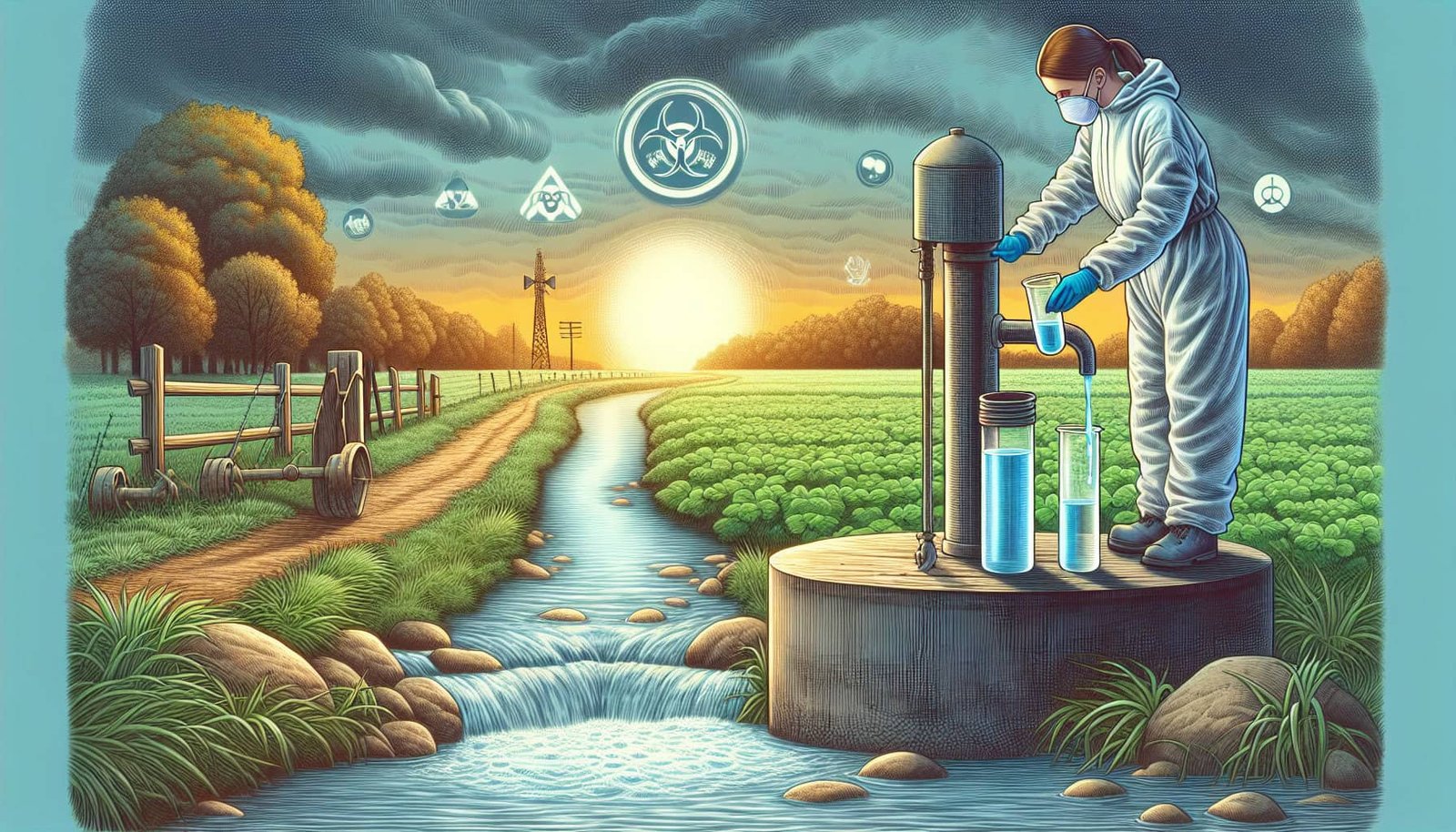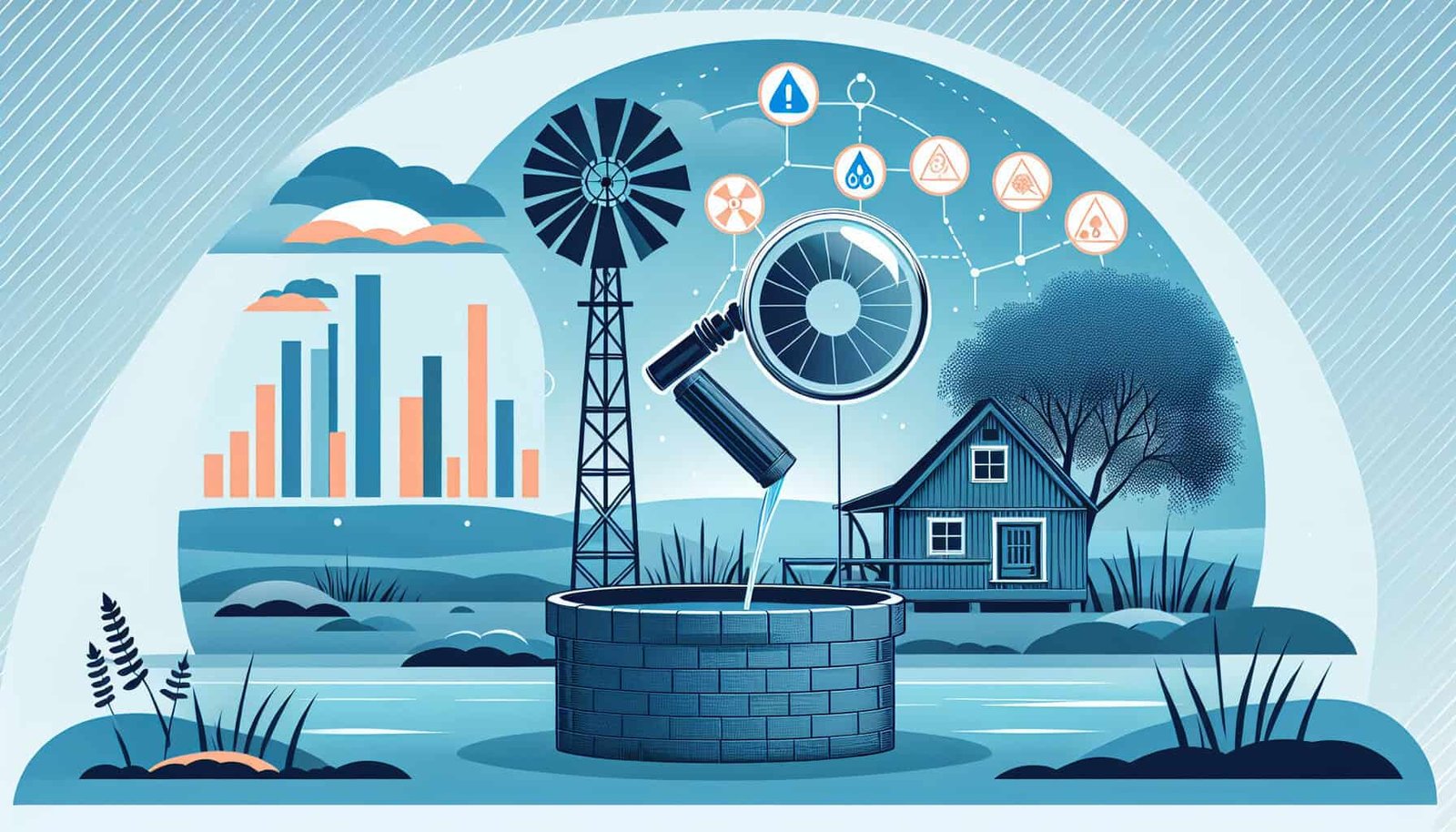Imagine living in a picturesque countryside, surrounded by lush greenery and tranquility. Life seems idyllic until you discover that the water you rely on for drinking, cooking, and bathing may harbor hidden dangers. In areas where well water is the primary source, the safety concerns around synthetic chemicals have become a pressing issue. The presence of these chemicals in well water is a cause for alarm, prompting rigorous testing and raising important questions about the health risks they may pose. In this article, we will explore the safety concerns associated with well water in areas undergoing testing for synthetic chemicals and delve into the potential implications for individuals who rely on well water for their daily needs.
Potential Contaminants in Well Water
Well water can be exposed to a variety of potential contaminants, including chemicals from industrial sources, agricultural chemicals and pesticides, synthetic compounds from household products, pharmaceuticals and personal care products, as well as lead and other heavy metals. These contaminants can find their way into the groundwater and subsequently into well water, posing a potential risk to human health.
Chemicals from Industrial Sources
Industrial facilities can contribute to the contamination of well water through the release of chemicals into the environment. These chemicals may include solvents, heavy metals, and other hazardous substances. If the well is located near an industrial site, there is a higher likelihood of contamination, especially if proper containment measures are not in place.
Agricultural Chemicals and Pesticides
Agricultural activities often involve the use of various chemicals and pesticides to enhance crop growth and protect against pests. However, these substances can easily leach into the ground and contaminate the surrounding water sources, including well water. The improper use or disposal of these chemicals can exacerbate the issue, posing a risk to those who consume contaminated well water.
Synthetic Compounds from Household Products
Common household products such as cleaning agents, detergents, and personal care products can contain synthetic compounds that, when washed down drains or disposed of improperly, can contaminate the groundwater. These compounds may include artificial fragrances, preservatives, and other chemicals that can find their way into the well water supply.
Pharmaceuticals and Personal Care Products
The presence of pharmaceuticals and personal care products in well water has increasingly become a concern. These include medications, hormones, and various chemicals used in personal care products, such as sunscreen and antibacterial soaps. Improper disposal of unused medications and ineffective wastewater treatment systems can contribute to the presence of these substances in the water supply.
Lead and other Heavy Metals
Lead and heavy metals can be present in well water, especially in older homes or areas with corrosive water sources. Lead pipes or outdated plumbing fixtures can introduce lead into the water supply, posing a significant health risk. Additionally, heavy metals from industrial activities or natural sources can contaminate the groundwater and subsequently affect the quality of well water.
Health Effects of Synthetic Chemicals in Well Water
Exposure to synthetic chemicals in well water can have various health effects on individuals. These effects can range from endocrine disruption and carcinogenicity to reproductive and developmental issues, as well as neurological and cognitive effects.
Endocrine Disruptors
Synthetic chemicals in well water, such as certain plastics and pesticides, can act as endocrine disruptors, interfering with the normal functioning of hormones in the body. Prolonged exposure to these chemicals can lead to hormonal imbalances and disrupt the endocrine system, potentially causing reproductive issues, developmental abnormalities, and other health problems.
Carcinogenic Compounds
Certain synthetic chemicals found in well water, such as benzene and trichloroethylene, have been classified as carcinogens. Prolonged exposure to these compounds through contaminated well water can increase the risk of developing various types of cancer, including bladder, kidney, and liver cancer. It is essential to monitor and address the presence of such chemicals in well water to prevent long-term health consequences.
Reproductive and Developmental Issues
Consistent exposure to synthetic chemicals in well water can have adverse effects on reproductive health and development. Some chemicals, such as phthalates and bisphenol-A (BPA), have been linked to infertility, hormonal imbalances, and even birth defects. Pregnant women and those planning to conceive should be particularly cautious and ensure the safety of their well water.
Neurological and Cognitive Effects
Certain synthetic chemicals, such as pesticides and industrial contaminants, have been associated with neurological and cognitive effects. These chemicals can affect the central nervous system and impair brain function. Long-term exposure to contaminated well water may increase the risk of neurological disorders, such as Parkinson’s disease and cognitive decline.

Regulations and Guidelines for Synthetic Chemicals in Well Water
Various regulations and guidelines have been established to ensure the safety of well water regarding synthetic chemicals. These include standards set by the Environmental Protection Agency (EPA), state and local regulations, as well as safe water levels for specific contaminants.
EPA Drinking Water Standards
The EPA has developed drinking water standards, including Maximum Contaminant Levels (MCLs) and treatment techniques for various contaminants, including synthetic chemicals. These standards provide a framework for ensuring safe drinking water and setting limits on the concentration of specific contaminants in well water.
State and Local Regulations
In addition to federal regulations, individual states and local agencies may have their own regulations and guidelines for synthetic chemicals in well water. These regulations can vary depending on specific regional factors, such as geological conditions and local industries. It is important for well owners to be aware of and comply with these regulations to maintain the safety of their well water.
Safe Water Levels for Specific Contaminants
Certain organizations, such as the World Health Organization (WHO), have established safe water levels or guidelines for specific contaminants in well water. These guidelines provide benchmarks for acceptable concentrations of contaminants and help ensure the safety of well water. Well owners should consult these guidelines and take appropriate measures to address any contaminants that exceed the recommended levels.
Testing Methods for Synthetic Chemicals in Well Water
Regular testing of well water is crucial to identify the presence of synthetic chemicals and ensure the safety of the water supply. Various testing methods and detection techniques can be employed to determine the concentration of specific contaminants in well water.
Sampling and Laboratory Analysis
Sampling involves collecting water samples from the well and sending them to a laboratory for analysis. The laboratory will perform tests to detect the presence and concentration of various contaminants, including synthetic chemicals. Well owners can work with certified laboratories or local health departments to ensure accurate testing and analysis.
Detection Techniques for Specific Chemicals
Different detection techniques can be used to analyze specific synthetic chemicals in well water. These techniques may include chromatography, mass spectrometry, and immunoassays, among others. Each technique is specific to certain chemicals and can provide accurate results regarding their presence and concentration in the water sample.
Frequency of Testing
The frequency of testing for synthetic chemicals in well water can depend on various factors, including local regulations and the history of contamination in the area. It is generally recommended to test well water at least once a year, particularly for common contaminants. However, in areas with higher risk or suspected contamination, more frequent testing may be necessary to ensure ongoing safety.

Potential Sources of Synthetic Chemical Contamination
Understanding the potential sources of synthetic chemical contamination is essential for preventing and addressing water quality issues in wells. Some common sources include industrial facilities, agricultural activities, residential and urban runoff, as well as septic systems.
Industrial Facilities
Industrial facilities, such as manufacturing plants and chemical production sites, can release harmful chemicals into the environment. If not properly managed and contained, these chemicals can seep into the groundwater and ultimately contaminate well water. Well owners in proximity to industrial areas need to be vigilant and regularly test their well water for potential contamination.
Agricultural Activities
The use of pesticides, fertilizers, and other chemicals in agriculture can lead to groundwater contamination. Improper application or run-off from fields can contribute to the presence of synthetic chemicals in the surrounding water sources, including well water. It is essential for well owners near agricultural areas to monitor and mitigate the potential risks associated with agricultural chemical use.
Residential and Urban Runoff
Residential and urban areas can contribute to synthetic chemical contamination through runoff from roads, lawns, and gardens. Rainwater can carry chemicals from fertilizers, pesticides, and other household products into the groundwater, affecting nearby wells. Well owners should adopt best management practices, such as responsible chemical use and landscaping techniques, to minimize the impact of residential and urban runoff on their well water quality.
Septic Systems
Improperly maintained or malfunctioning septic systems can release harmful chemicals and bacteria into the groundwater. These contaminants can potentially reach nearby wells and compromise the safety of the water supply. Regular maintenance and inspection of septic systems are necessary to prevent contamination and safeguard the quality of well water.
Effects of Climate Change on Well Water Safety
Climate change can have significant implications for the safety of well water, particularly regarding synthetic chemical contamination. Changing weather patterns and extreme events can increase the risks of flooding, water scarcity, and altered chemical transport and fate.
Increased Flooding and Contamination Risks
Climate change can lead to more frequent and intense rainfall events, increasing the potential for flooding. Floodwaters can carry contaminants from various sources, including industrial facilities, agricultural fields, and urban areas, into the groundwater and subsequently contaminate well water. Well owners in flood-prone areas should take steps to mitigate the risks, such as elevated well construction or improved containment measures.
Droughts and Water Scarcity
Climate change can also result in prolonged droughts and water scarcity in certain regions. During periods of drought, well water levels may decrease, potentially concentrating contaminants and synthetic chemicals in the remaining water supply. It is crucial for well owners in areas prone to drought to implement water conservation measures and regularly test their well water for any changes in quality.
Altered Chemical Transport and Fate
Changing weather patterns and temperature fluctuations can affect the transport and fate of synthetic chemicals in the environment. This can result in complex interactions and potentially alter the behavior of contaminants in well water. It is important for researchers and policymakers to continue studying these effects to develop appropriate strategies for mitigating the risks to well water quality.

Protecting Well Water from Synthetic Chemical Contamination
Protecting well water from synthetic chemical contamination requires proactive measures at different levels, including source water protection, best management practices in agriculture, proper disposal of household chemicals, and regular water testing and treatment.
Source Water Protection
Source water protection involves safeguarding the natural sources of groundwater, such as aquifers, from contamination. This can be achieved through land conservation, implementing buffer zones around wells, and managing activities that can pose a risk to water quality. By protecting the source water, the potential for synthetic chemical contamination can be minimized.
Best Management Practices in Agriculture
Implementing best management practices in agriculture can significantly reduce the risk of synthetic chemical contamination in well water. This includes proper chemical application, precision agriculture techniques, and using alternative pest control methods. Education and outreach programs can help farmers adopt these practices and ensure the protection of water resources.
Proper Disposal of Household Chemicals
Proper disposal of household chemicals is essential to prevent contamination of well water. This includes following guidelines for disposal of medications, household cleaners, and other substances that can endanger water quality. Well owners should utilize local community collection programs or designated drop-off sites to dispose of these chemicals responsibly.
Regular Water Testing and Treatment
Regular water testing and treatment are crucial in maintaining the safety of well water. Well owners should establish a testing schedule and work with certified laboratories to analyze their water for synthetic chemicals. If contaminants are detected, appropriate treatment methods, such as activated carbon filtration, reverse osmosis, UV disinfection, or distillation, can be employed to remove or reduce the presence of these chemicals.
Health Risks for Vulnerable Populations
Vulnerable populations, including children and infants, pregnant women, elderly individuals, and immunocompromised individuals, may face additional health risks when exposed to synthetic chemicals in well water.
Children and Infants
Children and infants may be more susceptible to the health effects of synthetic chemicals due to their developing immune systems and bodies. Prolonged exposure to certain contaminants, such as lead, can lead to cognitive and behavioral issues, as well as developmental delays. Ensuring the safety of well water is especially important for households with young children and infants.
Pregnant Women
Pregnant women require extra caution when consuming well water to protect both their health and the health of their unborn child. Exposure to certain synthetic chemicals during pregnancy can increase the risk of birth defects, preterm birth, and other complications. Regular testing and treatment of well water are essential to minimize the potential risks for pregnant women.
Elderly Individuals
Elderly individuals may have weakened immune systems and be more susceptible to the health effects of synthetic chemicals. These individuals may already be managing existing health conditions, and exposure to contaminants in well water can exacerbate their symptoms or lead to additional health complications. It is crucial for the elderly to ensure the safety of their well water through regular testing and appropriate treatment methods.
Immunocompromised Individuals
Immunocompromised individuals, such as those with compromised immune systems or chronic illnesses, are particularly vulnerable to the health risks associated with synthetic chemical exposure. Contaminated well water can further weaken their immune response and increase the likelihood of infections or other health issues. Strict adherence to water testing and treatment protocols is essential for this population to minimize potential risks.

Common Treatment Methods for Synthetic Chemical Removal
Various treatment methods can be employed to remove or reduce synthetic chemicals in well water. These methods include activated carbon filtration, reverse osmosis, UV disinfection, and distillation.
Activated Carbon Filtration
Activated carbon filtration is a widely used method for removing synthetic chemicals from well water. The porous structure of activated carbon effectively adsorbs contaminants, reducing their concentration in the water. This method can remove organic compounds, volatile organic compounds (VOCs), and certain pesticides, improving the overall quality of well water.
Reverse Osmosis
Reverse osmosis is an effective treatment method for removing synthetic chemicals, as well as other contaminants, from well water. It works by passing water through a semi-permeable membrane, removing particles, ions, and larger molecules. Reverse osmosis systems can effectively remove various synthetic chemicals, including pesticides, pharmaceuticals, and heavy metals.
UV Disinfection
UV disinfection utilizes ultraviolet light to destroy or inactivate microorganisms, including bacteria, viruses, and parasites, in well water. While it is not specifically designed to remove synthetic chemicals, this method can contribute to the overall safety and quality of well water by eliminating potential sources of contamination.
Distillation
Distillation is a process that involves heating water to create steam and then collecting the condensed steam as purified water. This method effectively removes contaminants with higher boiling points than water, including synthetic chemicals. However, it may not be as commonly used due to its energy-intensive nature.
Ensuring Safe Well Water in Affected Areas
In areas where well water testing reveals synthetic chemical contamination, several strategies can be implemented to ensure the long-term safety of the water supply. These strategies include community education and awareness, collaboration with local health departments, government funding for remediation efforts, and technical assistance for well owners.
Community Education and Awareness
Community education and awareness programs are crucial in informing residents about the potential risks associated with synthetic chemical contamination in well water. These programs can provide guidance on testing and treatment options, as well as proper well maintenance and best practices to minimize contamination. Engaging community members and promoting knowledge sharing can lead to improved water quality and increased well water safety.
Collaboration with Local Health Departments
Collaboration between well owners and local health departments is essential for addressing synthetic chemical contamination. Health departments can provide valuable resources, information, and support to well owners, including testing services, treatment recommendations, and guidance on complying with regulations. By working together, well owners and health departments can effectively protect the safety of well water.
Government Funding for Remediation
Government funding is crucial in supporting remediation efforts in areas affected by synthetic chemical contamination. Financial assistance can help well owners install appropriate treatment systems, upgrade existing infrastructure, or relocate wells away from contaminated areas. Government funding can also support research and development of innovative technologies to address emerging contaminants and ensure the long-term safety of well water.
Technical Assistance for Well Owners
Providing technical assistance to well owners can greatly enhance their ability to address synthetic chemical contamination. This assistance can include training on proper well maintenance, understanding water quality testing results, and guidance on selecting and installing treatment systems. Well owners can benefit from ongoing support and access to expert advice to ensure the ongoing safety of their well water.
In conclusion, ensuring the safety of well water in areas where synthetic chemical contamination is a concern requires a multi-faceted approach. From understanding the potential sources of contamination to implementing regulations and guidelines, as well as regular testing and treatment, protecting the quality of well water is crucial for safeguarding human health. By promoting awareness, collaboration, and the adoption of best management practices, individuals and communities can work together to ensure the long-term safety of well water.


